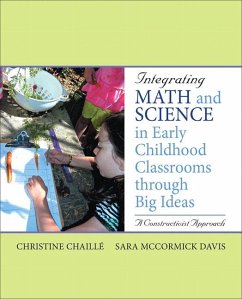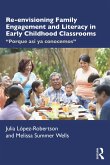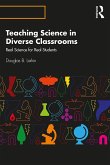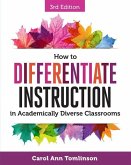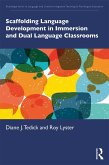Christine Chaille, Sara Davis
Integrating Math and Science in Early Childhood Classrooms Through Big Ideas
A Constructivist Approach
101,99 €
inkl. MwSt.
Versandkostenfrei*
Liefertermin unbestimmt
Melden Sie sich
hier
hier
für den Produktalarm an, um über die Verfügbarkeit des Produkts informiert zu werden.

51 °P sammeln
Christine Chaille, Sara Davis
Integrating Math and Science in Early Childhood Classrooms Through Big Ideas
A Constructivist Approach
- Broschiertes Buch
For courses in Mathematics in Early Childhood Education and/or Science in Early Childhood Education, ages three to eight.
How to use big ideas like patterns, transformation, movement, balance, and relationships as a way to think about whatever content knowledge is needed.
Integrating Math and Science in Early Childhood Classrooms Through Big Ideas offers a way to think about the future classroom and to meet the needs of children who come to into it with diverse experience, knowledge, and abilities. "Change how we think about math and science for young children," the authors say in their…mehr
Andere Kunden interessierten sich auch für
![Integrating Inquiry in Social Studies Classrooms Integrating Inquiry in Social Studies Classrooms]() Carolyn WeberIntegrating Inquiry in Social Studies Classrooms36,99 €
Carolyn WeberIntegrating Inquiry in Social Studies Classrooms36,99 €![Re-envisioning Family Engagement and Literacy in Early Childhood Classrooms Re-envisioning Family Engagement and Literacy in Early Childhood Classrooms]() Julia Lopez-RobertsonRe-envisioning Family Engagement and Literacy in Early Childhood Classrooms48,99 €
Julia Lopez-RobertsonRe-envisioning Family Engagement and Literacy in Early Childhood Classrooms48,99 €![Teaching Science in Diverse Classrooms Teaching Science in Diverse Classrooms]() Douglas B. LarkinTeaching Science in Diverse Classrooms58,99 €
Douglas B. LarkinTeaching Science in Diverse Classrooms58,99 €![How to Differentiate Instruction in Academically Diverse Classrooms How to Differentiate Instruction in Academically Diverse Classrooms]() Carol Ann TomlinsonHow to Differentiate Instruction in Academically Diverse Classrooms27,99 €
Carol Ann TomlinsonHow to Differentiate Instruction in Academically Diverse Classrooms27,99 €![Scaffolding Language Development in Immersion and Dual Language Classrooms Scaffolding Language Development in Immersion and Dual Language Classrooms]() Diane J. TedickScaffolding Language Development in Immersion and Dual Language Classrooms46,99 €
Diane J. TedickScaffolding Language Development in Immersion and Dual Language Classrooms46,99 €![Creating Critical Classrooms Creating Critical Classrooms]() Mitzi Lewison (USA Indiana University-Bloomington)Creating Critical Classrooms73,99 €
Mitzi Lewison (USA Indiana University-Bloomington)Creating Critical Classrooms73,99 €![Negotiating Critical Literacies in Classrooms Negotiating Critical Literacies in Classrooms]() Negotiating Critical Literacies in Classrooms58,99 €
Negotiating Critical Literacies in Classrooms58,99 €-
-
-
For courses in Mathematics in Early Childhood Education and/or Science in Early Childhood Education, ages three to eight.
How to use big ideas like patterns, transformation, movement, balance, and relationships as a way to think about whatever content knowledge is needed.
Integrating Math and Science in Early Childhood Classrooms Through Big Ideas offers a way to think about the future classroom and to meet the needs of children who come to into it with diverse experience, knowledge, and abilities. "Change how we think about math and science for young children," the authors say in their Preface. "Instead of separating the disciplines, planning lessons and topics and projects aimed at math OR science content, let's look at the world the way the child does. Children think in terms of big ideas."
In this unique book, the authors focus on big ideas-like patterns, transformation, movement, balance, and relationships-as a way tothink about content, and they integrate science and mathematics through these big ideas, rather than linking them topically. The book looks at why it is important to think about thinking, introduces assessment early to help the teacher plan for assessment before teaching even begins, and sets up an environment that will support the construction of the big ideas that integrate math and science. Real-life scenarios provide invaluable insights into the teacher's thinking and planning, and each chapter includes two modules to be used for in-depth exploration of different aspects of the big ideas. It's a unique exploration of thinking and learning.
How to use big ideas like patterns, transformation, movement, balance, and relationships as a way to think about whatever content knowledge is needed.
Integrating Math and Science in Early Childhood Classrooms Through Big Ideas offers a way to think about the future classroom and to meet the needs of children who come to into it with diverse experience, knowledge, and abilities. "Change how we think about math and science for young children," the authors say in their Preface. "Instead of separating the disciplines, planning lessons and topics and projects aimed at math OR science content, let's look at the world the way the child does. Children think in terms of big ideas."
In this unique book, the authors focus on big ideas-like patterns, transformation, movement, balance, and relationships-as a way tothink about content, and they integrate science and mathematics through these big ideas, rather than linking them topically. The book looks at why it is important to think about thinking, introduces assessment early to help the teacher plan for assessment before teaching even begins, and sets up an environment that will support the construction of the big ideas that integrate math and science. Real-life scenarios provide invaluable insights into the teacher's thinking and planning, and each chapter includes two modules to be used for in-depth exploration of different aspects of the big ideas. It's a unique exploration of thinking and learning.
Produktdetails
- Produktdetails
- Verlag: Pearson
- Seitenzahl: 256
- Erscheinungstermin: 19. Januar 2015
- Englisch
- Abmessung: 233mm x 190mm x 15mm
- Gewicht: 366g
- ISBN-13: 9780137145799
- ISBN-10: 0137145799
- Artikelnr.: 42130097
- Verlag: Pearson
- Seitenzahl: 256
- Erscheinungstermin: 19. Januar 2015
- Englisch
- Abmessung: 233mm x 190mm x 15mm
- Gewicht: 366g
- ISBN-13: 9780137145799
- ISBN-10: 0137145799
- Artikelnr.: 42130097
Christine Chaille is Professor and chair of the department of Curriculum and Instruction at Portland State University, focusing on early childhood education, where she has taught since 1991. Her doctorate is from U.C.L.A., and she also studied with Jean Piaget at the University of Geneva. She is the author of Constructivism Across the Early Childhood Curriculum: Big Ideas as Inspiration, and co-author, with Lory Britain, of The Young Child as Scientist: A Constructivist Approach to Early Childhood Science Education, has written many publications primarily on the importance of children’s play. She has also developed a child development curriculum for Hands to Hearts International that is used with caregivers in orphanages in Southern India, as well as in other countries and with other vulnerable populations. She was a panel member responsible for developing the NSTA Position statement on Early Childhood Science Education (2014). She has served as President of the Oregon Association for the education of Young Children, President of the National association of Early Childhood Teacher educators, and Chair of the early education/Child Development Special Interest Group of the American Educational Research Association, and is the recipient of the Outstanding Early Childhood Teacher Educator award for 2013 from the National Association of early Childhood Teacher Education. Sara McCormick Davis has degrees in Family Relations/Child Development and Early Childhood Education. Her doctorate is in Curriculum and Instruction from Oklahoma State University. She taught preschool through fifth grade for many years before working with teachers, both pre service and in service. As a preschool/elementary classroom teacher, one of her goals was to always have a project going in her classroom that helped children construct new ideas. Her interests and work have revolved around how teachers can integrate curriculum so that children are engaged and learning. She has published about the integration of the arts in teacher education and researched practices of classroom teachers as they work to create environments where everyone can flourish.
Brief Table Of Contents
Chapter 1: Constructivist Curriculum Framework for the Integration of Math
and Science in Early Childhood Classrooms
Chapter 2: Assessment
Chapter 3: Creating an Environment for Math and Science Integration
Chapter 4: Patterns
Chapter 5: Transformation
Chapter 6: Movement
Chapter 7: Balance and Symmetry
Chapter 8: Relationships
Chapter 9: Developing Your Own Curriculum: Big Ideas and Planning
References
Glossary
Detailed Table Of Contents
PART I: Introduction
Chapter 1: Constructivist Curriculum Framework for the Integration of Math
and Science in Early Childhood Classrooms
Children as Theory-Builders
What Is Constructivism?
Big Ideas as Tools for Integration
What Is a Big Idea?
Characteristics of Big Ideas
Views of Teaching and Learning
The Child at the Center
Celebration of the Diversity of Children
What About Content?
Child-Centered Versus Teacher-Directed Curriculum: A False Dichotomy
Background on the Model of Curriculum Integration Used in This Book
Historical Context
Models of Curriculum Integration
The Project Approach
Big Ideas, Projects, Concepts, Topics, and Facts: What Are the Differences?
The Work of Reggio Emilia
Review Questions
Summary
Websites
Chapter 2: Assessment
Why Begin with Assessment?
Understanding Children’s Development
Principles of Development
Responding to Children’s Needs
Culture and Context 24
Principles of Assessment
Assessment Should Be Valid
Assessment Should Guide Teaching Decisions
Assessment Should Be Part of a System That Is Designed to Support the Whole
Child
Vocabulary Development and Assessment
Teacher Language
Documentation of Children’s Learning as Assessment
Documentation Strategies for Integrated Math and Science
Capturing the Documentation
More Formalized Assessment Tools
Science and Math Journals
Interviewing for Assessment
Questions That Help with Assessment
Interviewing Activities
Standards and Assessment
Standardized Testing
EdTPA
Review Questions
Summary
Websites
Chapter 3: Creating an Environment for Math and Science Integration
How Our Beliefs About Children, Teaching, and Learning Shape Our
Environments
Academic Environment
Physical Environment
Classroom Organization
Differentiation Built into the Environment
Animals in the Classroom
Communicating with Families and Others Through the Environment
Review Questions
Summary
Websites
PART II: Integration Through Big Ideas
Chapter 4: Patterns
Patterns
What Is Important About Patterns? Why Do We Talk About Patterns with Young
Children?
Elements of the Big Idea of Patterns
Repeating Patterns
Spatial Structure Patterns
Growing Patterns
Subitizing
Seriation and Sequencing
Patterns Surround Us
Patterns Help Us Predict
Patterns Help Us Make Connections
Patterns Help Us Organize Information
Review Questions
Summary
Chapter 5: Transformation
What Is Transformation?
Relationship Building as a Part of Transformation
Equivalence as Part of Transformation
Exploration of Transformation
Observation
Estimation
Experimentation
Growth
Review Questions
Summary
Chapter 6: Movement
Introduction to the Big Idea of Movement
Elements of the Big Idea of Movement
Direction of Movement
Representation of Movement
Types of Movement
Movement of the Surface
Sources of Movement
Mysterious Movement
Spinning
The Movement of Time
Review Questions
Summary
Chapter 7: Balance and Symmetry
Elements of the Big Idea of Balance
Comparisons
Patterns
The Establishment of Equality
Exploration of Balance
The Study of Symmetry
Comparisons and Tools of Measurement
The Use of Representations
Games That Incorporate Balance: Physical Knowledge
Review Questions
Summary
Chapter 8: Relationships
Introduction to the Big Idea of Relationships
Elements of the Big Idea of Relationships
Cause and Effect
Part/Whole Relationships
Classification
Perspective-Taking and Interdependence
Review Questions
Summary
Chapter 9: Developing Your Own Curriculum: Big Ideas and Planning
Determining the Big Idea
Coming up with New Big Ideas
Re-thinking an Activity, Project, or Unit
Starting with Children’s Interests
Starting with an Event
Starting with Where You Are
Start with an Interest of Yours
Starting with the Standards
The Planning Process: Strategies for Thinking About Planning
The Planning Process: What Does It Look Like?
Planning for Integration and Inquiry
The Project Approach
Planning with the End in Sight
The Five E Learning Cycle
Using Other Areas of the Curriculum to Strengthen Math and Science
Connecting Language Arts, Math, and Science
Connecting Children’s Literature, Math, and Science
Cognitively Guided Instruction
Starting with a Standard
Connecting the Arts, Math and Science
Connecting Social Studies, Math and Science
Review Questions
Summary
Websites
References
Glossary
Name Index
Subject Index
Chapter 1: Constructivist Curriculum Framework for the Integration of Math
and Science in Early Childhood Classrooms
Chapter 2: Assessment
Chapter 3: Creating an Environment for Math and Science Integration
Chapter 4: Patterns
Chapter 5: Transformation
Chapter 6: Movement
Chapter 7: Balance and Symmetry
Chapter 8: Relationships
Chapter 9: Developing Your Own Curriculum: Big Ideas and Planning
References
Glossary
Detailed Table Of Contents
PART I: Introduction
Chapter 1: Constructivist Curriculum Framework for the Integration of Math
and Science in Early Childhood Classrooms
Children as Theory-Builders
What Is Constructivism?
Big Ideas as Tools for Integration
What Is a Big Idea?
Characteristics of Big Ideas
Views of Teaching and Learning
The Child at the Center
Celebration of the Diversity of Children
What About Content?
Child-Centered Versus Teacher-Directed Curriculum: A False Dichotomy
Background on the Model of Curriculum Integration Used in This Book
Historical Context
Models of Curriculum Integration
The Project Approach
Big Ideas, Projects, Concepts, Topics, and Facts: What Are the Differences?
The Work of Reggio Emilia
Review Questions
Summary
Websites
Chapter 2: Assessment
Why Begin with Assessment?
Understanding Children’s Development
Principles of Development
Responding to Children’s Needs
Culture and Context 24
Principles of Assessment
Assessment Should Be Valid
Assessment Should Guide Teaching Decisions
Assessment Should Be Part of a System That Is Designed to Support the Whole
Child
Vocabulary Development and Assessment
Teacher Language
Documentation of Children’s Learning as Assessment
Documentation Strategies for Integrated Math and Science
Capturing the Documentation
More Formalized Assessment Tools
Science and Math Journals
Interviewing for Assessment
Questions That Help with Assessment
Interviewing Activities
Standards and Assessment
Standardized Testing
EdTPA
Review Questions
Summary
Websites
Chapter 3: Creating an Environment for Math and Science Integration
How Our Beliefs About Children, Teaching, and Learning Shape Our
Environments
Academic Environment
Physical Environment
Classroom Organization
Differentiation Built into the Environment
Animals in the Classroom
Communicating with Families and Others Through the Environment
Review Questions
Summary
Websites
PART II: Integration Through Big Ideas
Chapter 4: Patterns
Patterns
What Is Important About Patterns? Why Do We Talk About Patterns with Young
Children?
Elements of the Big Idea of Patterns
Repeating Patterns
Spatial Structure Patterns
Growing Patterns
Subitizing
Seriation and Sequencing
Patterns Surround Us
Patterns Help Us Predict
Patterns Help Us Make Connections
Patterns Help Us Organize Information
Review Questions
Summary
Chapter 5: Transformation
What Is Transformation?
Relationship Building as a Part of Transformation
Equivalence as Part of Transformation
Exploration of Transformation
Observation
Estimation
Experimentation
Growth
Review Questions
Summary
Chapter 6: Movement
Introduction to the Big Idea of Movement
Elements of the Big Idea of Movement
Direction of Movement
Representation of Movement
Types of Movement
Movement of the Surface
Sources of Movement
Mysterious Movement
Spinning
The Movement of Time
Review Questions
Summary
Chapter 7: Balance and Symmetry
Elements of the Big Idea of Balance
Comparisons
Patterns
The Establishment of Equality
Exploration of Balance
The Study of Symmetry
Comparisons and Tools of Measurement
The Use of Representations
Games That Incorporate Balance: Physical Knowledge
Review Questions
Summary
Chapter 8: Relationships
Introduction to the Big Idea of Relationships
Elements of the Big Idea of Relationships
Cause and Effect
Part/Whole Relationships
Classification
Perspective-Taking and Interdependence
Review Questions
Summary
Chapter 9: Developing Your Own Curriculum: Big Ideas and Planning
Determining the Big Idea
Coming up with New Big Ideas
Re-thinking an Activity, Project, or Unit
Starting with Children’s Interests
Starting with an Event
Starting with Where You Are
Start with an Interest of Yours
Starting with the Standards
The Planning Process: Strategies for Thinking About Planning
The Planning Process: What Does It Look Like?
Planning for Integration and Inquiry
The Project Approach
Planning with the End in Sight
The Five E Learning Cycle
Using Other Areas of the Curriculum to Strengthen Math and Science
Connecting Language Arts, Math, and Science
Connecting Children’s Literature, Math, and Science
Cognitively Guided Instruction
Starting with a Standard
Connecting the Arts, Math and Science
Connecting Social Studies, Math and Science
Review Questions
Summary
Websites
References
Glossary
Name Index
Subject Index
Brief Table Of Contents
Chapter 1: Constructivist Curriculum Framework for the Integration of Math
and Science in Early Childhood Classrooms
Chapter 2: Assessment
Chapter 3: Creating an Environment for Math and Science Integration
Chapter 4: Patterns
Chapter 5: Transformation
Chapter 6: Movement
Chapter 7: Balance and Symmetry
Chapter 8: Relationships
Chapter 9: Developing Your Own Curriculum: Big Ideas and Planning
References
Glossary
Detailed Table Of Contents
PART I: Introduction
Chapter 1: Constructivist Curriculum Framework for the Integration of Math
and Science in Early Childhood Classrooms
Children as Theory-Builders
What Is Constructivism?
Big Ideas as Tools for Integration
What Is a Big Idea?
Characteristics of Big Ideas
Views of Teaching and Learning
The Child at the Center
Celebration of the Diversity of Children
What About Content?
Child-Centered Versus Teacher-Directed Curriculum: A False Dichotomy
Background on the Model of Curriculum Integration Used in This Book
Historical Context
Models of Curriculum Integration
The Project Approach
Big Ideas, Projects, Concepts, Topics, and Facts: What Are the Differences?
The Work of Reggio Emilia
Review Questions
Summary
Websites
Chapter 2: Assessment
Why Begin with Assessment?
Understanding Children’s Development
Principles of Development
Responding to Children’s Needs
Culture and Context 24
Principles of Assessment
Assessment Should Be Valid
Assessment Should Guide Teaching Decisions
Assessment Should Be Part of a System That Is Designed to Support the Whole
Child
Vocabulary Development and Assessment
Teacher Language
Documentation of Children’s Learning as Assessment
Documentation Strategies for Integrated Math and Science
Capturing the Documentation
More Formalized Assessment Tools
Science and Math Journals
Interviewing for Assessment
Questions That Help with Assessment
Interviewing Activities
Standards and Assessment
Standardized Testing
EdTPA
Review Questions
Summary
Websites
Chapter 3: Creating an Environment for Math and Science Integration
How Our Beliefs About Children, Teaching, and Learning Shape Our
Environments
Academic Environment
Physical Environment
Classroom Organization
Differentiation Built into the Environment
Animals in the Classroom
Communicating with Families and Others Through the Environment
Review Questions
Summary
Websites
PART II: Integration Through Big Ideas
Chapter 4: Patterns
Patterns
What Is Important About Patterns? Why Do We Talk About Patterns with Young
Children?
Elements of the Big Idea of Patterns
Repeating Patterns
Spatial Structure Patterns
Growing Patterns
Subitizing
Seriation and Sequencing
Patterns Surround Us
Patterns Help Us Predict
Patterns Help Us Make Connections
Patterns Help Us Organize Information
Review Questions
Summary
Chapter 5: Transformation
What Is Transformation?
Relationship Building as a Part of Transformation
Equivalence as Part of Transformation
Exploration of Transformation
Observation
Estimation
Experimentation
Growth
Review Questions
Summary
Chapter 6: Movement
Introduction to the Big Idea of Movement
Elements of the Big Idea of Movement
Direction of Movement
Representation of Movement
Types of Movement
Movement of the Surface
Sources of Movement
Mysterious Movement
Spinning
The Movement of Time
Review Questions
Summary
Chapter 7: Balance and Symmetry
Elements of the Big Idea of Balance
Comparisons
Patterns
The Establishment of Equality
Exploration of Balance
The Study of Symmetry
Comparisons and Tools of Measurement
The Use of Representations
Games That Incorporate Balance: Physical Knowledge
Review Questions
Summary
Chapter 8: Relationships
Introduction to the Big Idea of Relationships
Elements of the Big Idea of Relationships
Cause and Effect
Part/Whole Relationships
Classification
Perspective-Taking and Interdependence
Review Questions
Summary
Chapter 9: Developing Your Own Curriculum: Big Ideas and Planning
Determining the Big Idea
Coming up with New Big Ideas
Re-thinking an Activity, Project, or Unit
Starting with Children’s Interests
Starting with an Event
Starting with Where You Are
Start with an Interest of Yours
Starting with the Standards
The Planning Process: Strategies for Thinking About Planning
The Planning Process: What Does It Look Like?
Planning for Integration and Inquiry
The Project Approach
Planning with the End in Sight
The Five E Learning Cycle
Using Other Areas of the Curriculum to Strengthen Math and Science
Connecting Language Arts, Math, and Science
Connecting Children’s Literature, Math, and Science
Cognitively Guided Instruction
Starting with a Standard
Connecting the Arts, Math and Science
Connecting Social Studies, Math and Science
Review Questions
Summary
Websites
References
Glossary
Name Index
Subject Index
Chapter 1: Constructivist Curriculum Framework for the Integration of Math
and Science in Early Childhood Classrooms
Chapter 2: Assessment
Chapter 3: Creating an Environment for Math and Science Integration
Chapter 4: Patterns
Chapter 5: Transformation
Chapter 6: Movement
Chapter 7: Balance and Symmetry
Chapter 8: Relationships
Chapter 9: Developing Your Own Curriculum: Big Ideas and Planning
References
Glossary
Detailed Table Of Contents
PART I: Introduction
Chapter 1: Constructivist Curriculum Framework for the Integration of Math
and Science in Early Childhood Classrooms
Children as Theory-Builders
What Is Constructivism?
Big Ideas as Tools for Integration
What Is a Big Idea?
Characteristics of Big Ideas
Views of Teaching and Learning
The Child at the Center
Celebration of the Diversity of Children
What About Content?
Child-Centered Versus Teacher-Directed Curriculum: A False Dichotomy
Background on the Model of Curriculum Integration Used in This Book
Historical Context
Models of Curriculum Integration
The Project Approach
Big Ideas, Projects, Concepts, Topics, and Facts: What Are the Differences?
The Work of Reggio Emilia
Review Questions
Summary
Websites
Chapter 2: Assessment
Why Begin with Assessment?
Understanding Children’s Development
Principles of Development
Responding to Children’s Needs
Culture and Context 24
Principles of Assessment
Assessment Should Be Valid
Assessment Should Guide Teaching Decisions
Assessment Should Be Part of a System That Is Designed to Support the Whole
Child
Vocabulary Development and Assessment
Teacher Language
Documentation of Children’s Learning as Assessment
Documentation Strategies for Integrated Math and Science
Capturing the Documentation
More Formalized Assessment Tools
Science and Math Journals
Interviewing for Assessment
Questions That Help with Assessment
Interviewing Activities
Standards and Assessment
Standardized Testing
EdTPA
Review Questions
Summary
Websites
Chapter 3: Creating an Environment for Math and Science Integration
How Our Beliefs About Children, Teaching, and Learning Shape Our
Environments
Academic Environment
Physical Environment
Classroom Organization
Differentiation Built into the Environment
Animals in the Classroom
Communicating with Families and Others Through the Environment
Review Questions
Summary
Websites
PART II: Integration Through Big Ideas
Chapter 4: Patterns
Patterns
What Is Important About Patterns? Why Do We Talk About Patterns with Young
Children?
Elements of the Big Idea of Patterns
Repeating Patterns
Spatial Structure Patterns
Growing Patterns
Subitizing
Seriation and Sequencing
Patterns Surround Us
Patterns Help Us Predict
Patterns Help Us Make Connections
Patterns Help Us Organize Information
Review Questions
Summary
Chapter 5: Transformation
What Is Transformation?
Relationship Building as a Part of Transformation
Equivalence as Part of Transformation
Exploration of Transformation
Observation
Estimation
Experimentation
Growth
Review Questions
Summary
Chapter 6: Movement
Introduction to the Big Idea of Movement
Elements of the Big Idea of Movement
Direction of Movement
Representation of Movement
Types of Movement
Movement of the Surface
Sources of Movement
Mysterious Movement
Spinning
The Movement of Time
Review Questions
Summary
Chapter 7: Balance and Symmetry
Elements of the Big Idea of Balance
Comparisons
Patterns
The Establishment of Equality
Exploration of Balance
The Study of Symmetry
Comparisons and Tools of Measurement
The Use of Representations
Games That Incorporate Balance: Physical Knowledge
Review Questions
Summary
Chapter 8: Relationships
Introduction to the Big Idea of Relationships
Elements of the Big Idea of Relationships
Cause and Effect
Part/Whole Relationships
Classification
Perspective-Taking and Interdependence
Review Questions
Summary
Chapter 9: Developing Your Own Curriculum: Big Ideas and Planning
Determining the Big Idea
Coming up with New Big Ideas
Re-thinking an Activity, Project, or Unit
Starting with Children’s Interests
Starting with an Event
Starting with Where You Are
Start with an Interest of Yours
Starting with the Standards
The Planning Process: Strategies for Thinking About Planning
The Planning Process: What Does It Look Like?
Planning for Integration and Inquiry
The Project Approach
Planning with the End in Sight
The Five E Learning Cycle
Using Other Areas of the Curriculum to Strengthen Math and Science
Connecting Language Arts, Math, and Science
Connecting Children’s Literature, Math, and Science
Cognitively Guided Instruction
Starting with a Standard
Connecting the Arts, Math and Science
Connecting Social Studies, Math and Science
Review Questions
Summary
Websites
References
Glossary
Name Index
Subject Index
